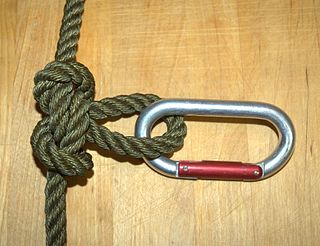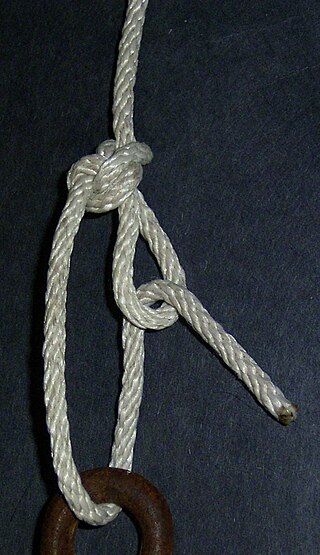
The butterfly loop, also known as lineman's loop, butterfly knot, alpine butterfly knot and lineman's rider, is a knot used to form a fixed loop in the middle of a rope. Tied in the bight, it can be made in a rope without access to either of the ends; this is a distinct advantage when working with long climbing ropes. The butterfly loop is an excellent mid-line rigging knot; it handles multi-directional loading well and has a symmetrical shape that makes it easy to inspect. In a climbing context it is also useful for traverse lines, some anchors, shortening rope slings, and for isolating damaged sections of rope.

The boa knot is a modern binding knot invented by weaver Peter Collingwood in 1996. His intention was to develop a knot that would hold well when the constricted object was cut close to the winds of the knot.

The trucker's hitch is a compound knot commonly used for securing loads on trucks or trailers. The general arrangement, using loops and turns in the rope itself to form a crude block and tackle, has long been used to tension lines and is known by multiple names. Knot author Geoffrey Budworth claims the knot can be traced back to the days when carters and hawkers used horse-drawn conveyances to move their wares from place to place.

The marlinespike hitch is a temporary knot used to attach a rod to a rope in order to form a handle. This allows more tension than could be produced comfortably by gripping the rope with the hands alone. It is useful when tightening knots and for other purposes in ropework.

Figure-eight loop is a type of knot created by a loop on the bight. It is used in climbing and caving.
The Flemish loop or figure-eight loop is perhaps stronger than the loop knot. Neither of these knots is used at sea, as they are hard to untie. In hooking a tackle to any of the loops, if the loop is long enough it is better to arrange the rope as a cat's paw.

The slippery eight loop is an adjustable loop knot discovered by Dave Poston in 2002.

The taut-line hitch is an adjustable loop knot for use on lines under tension. It is useful when the length of a line will need to be periodically adjusted in order to maintain tension. It is made by tying a rolling hitch around the standing part after passing around an anchor object. Tension is maintained by sliding the hitch to adjust the size of the loop, thus changing the effective length of the standing part without retying the knot.

A double bowline is a type of loop knot. Instead of the single turn of the regular bowline, the double bowline uses a round turn. This forms a more secure loop than a standard bowline.

The cow hitch, also called the lark's head, is a hitch knot used to attach a rope to an object. The cow hitch comprises a pair of single hitches tied in opposing directions, as compared to the clove hitch in which the single hitches are tied in the same direction. It has several variations and is known under a variety of names. It can be tied either with the end of the rope or with a bight.

The adjustable grip hitch is a simple and useful friction hitch which may easily be shifted up and down the rope while slack. It will hold fast when loaded, but slip when shock loaded until tension is relieved enough for it to again hold fast. It serves the same purpose as the taut-line hitch, e.g. tensioning a tent's guy line.

A becket hitch, including the double becket or figure-of-eight becket hitch, is any hitch that is made on an eye loop, i.e. on a becket. A becket hitch has the same structure as the sheet bend, which joins, or "bends", the ends of two ropes together. The becket hitch, in contrast, fixes a rope to a closed eye or hook. In this instance, a becket means the eye or hook of a pulley block, an eye in the end of a rope, or a rope handle on a sailor's sea chest.

The stevedore knot is a stopper knot, often tied near the end of a rope. It is more bulky and less prone to jamming than the closely related figure-eight knot.
The bight is given one more half turn than in the former knot [which itself is given, "one additional half twist," more than the figure-eight knot], before the end is finally stuck.

The bowline on a bight is a knot which makes a pair of fixed-size loops in the middle of a rope. Its advantage is that it is reasonably easy to untie after being exposed to load. It is one of the two tie-in knots that are being taught by the German Alpine Club (DAV), generally being considered secure.

In knot theory, the Whitehead link, named for J. H. C. Whitehead, is one of the most basic links. It can be drawn as an alternating link with five crossings, from the overlay of a circle and a figure-eight shaped loop.

The figure-of-nine loop is a type of knot to form a fixed loop in a rope. Tied in the bight, it is made similarly to a figure-of-eight loop but with an extra half-turn before finishing the knot.

In knot tying, a bight is a curved section or slack part between the two ends of a rope, string, or yarn. A knot that can be tied using only the bight of a rope, without access to the ends, is described as in the bight. The term "bight" is also used in a more specific way when describing Turk's head knots, indicating how many repetitions of braiding are made in the circuit of a given knot.

The trident loop is a fixed loop knot which can jam when heavily loaded. It was proposed as a replacement for the figure-of-eight loop for use in climbing by Robert M. Wolfe, MD, who developed it as a loop form of Ashley's bend. While some tests indicate its strength lies somewhere between the weaker Bowline and stronger figure-of-eight loop, the trident loop shows exceptional resistance to slipping in shock-loading tests.
The harness knot is a general purpose bend knot used to join two ropes together. The knot can be tied under tension and will not capsize.
This page is based on this
Wikipedia article Text is available under the
CC BY-SA 4.0 license; additional terms may apply.
Images, videos and audio are available under their respective licenses.



















